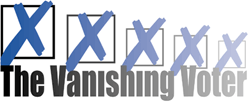
A Project to Study and Invigorate the American Electoral Process
The Vanishing Voter: Public Involvement in an Age of Uncertainty
Thomas E. Patterson, Shorenstein Center, John F. Kennedy School of Government, Harvard University
Alfred A. Knopf Publishers, September, 2002
During the 2000 presidential campaign with the support of a grant from The Pew Charitable Trusts, the Joan Shorenstein Center on the Press, Politics and Public Policy conducted the most exhaustive study yet of citizen involvement in an election campaign. From November 1999 to January 2001, we surveyed 1,000 Americans once or twice each week. In total, we ran questions on 99 surveys, collected data on 97,797 respondents, and asked several hundred unique survey questions.
This evidence was combined with surveys and other materials from past elections in an effort to better understand some of the reasons why Americans have been losing interest in campaigns. The period from 1960 to 2000 marks the longest ebb in voter turnout in the nation’s history. Fewer voters are not the only sign of waning interest. In 1960, 60 percent of the nation’s television households had their sets on and tuned to the October presidential debates. In 2000, fewer than 30 percent were tuned in. The results of our study are available in a book written by Thomas E. Patterson, the study’s co-director, who is the Bradlee Professor of Government and the Press at Harvard University’s Kennedy School of Government. Titled The Vanishing Voter: Civic Involvement in an Age of Uncertainty (Knopf, 2002), the book says, for example, that:
- the weakening of the political parties as objects of thought and loyalty has reduced the incentive to participate, particularly among lower-income Americans;
- modern campaign techniques are a turn-off for some citizens who otherwise have an interest in public affairs;
- attack journalism has eroded trust and interest in partisan politics, particularly among young adults;
- soft news has reduced the level of election coverage which, in turn, has reduced the frequency with which Americans think and talk about the campaign;
- the front-loading of the nominating system depresses not only turnout but election interest, information, and conversation in states with late-scheduled contests;
- the declining audiences for election telecasts are in part a function of sharp cutbacks in the broadcast networks’ coverage, which has reduced the number who “inadvertently” tune to these telecasts;
- registration closing dates and poll closing hours continue to keep some Americans from exercising their right to vote; and
- Electoral College strategies serve to depress turnout and other forms of involvement (for example, election-related conversation) in non-battleground states.
The book’s concluding chapter includes policy proposals that, if instituted by the parties, candidates, the media, and policymakers, would increase campaign involvement, not only on Election Day but throughout the course of the campaign.

